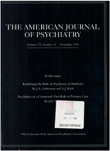PTSD among Israeli former prisoners of war and soldiers with combat stress reaction: a longitudinal study
Abstract
OBJECTIVE: The aim of this study was to assess the long-term impact of war captivity and combat stress reaction on rates of posttraumatic stress disorder (PTSD) in Israeli veterans of the 1973 Yom Kippur war. METHOD: One hundred sixty-four former prisoners of war (POWs), 112 veterans who had had combat stress reaction, and 184 combat veteran comparison subjects filled out the PTSD Inventory, a self-report scale based on the DSM-III-R criteria for PTSD. The inventory diagnoses past and present PTSD, assesses its intensity, and provides a symptom profile. RESULTS: Thirty-seven percent of the veterans who had had combat stress reaction, 23% of the former POWs, and 14% of the comparison subjects had had diagnosable PTSD at some time in the past. The current rates were 13%, 13%, and 3%, respectively. The results showed different recovery rates over time: almost two-thirds of the veterans with combat stress reaction who had had PTSD in the past recovered, while less than one-half of the POW group showed this improvement. CONCLUSIONS: These findings indicate that small but significant proportions of the POWs and veterans with combat stress reaction were still suffering from PTSD almost two decades after the war. The different recovery rates in the two groups may reflect the differences in duration and severity of stressors, the impact of immediate intervention on long-term adjustment, or both.
Access content
To read the fulltext, please use one of the options below to sign in or purchase access.- Personal login
- Institutional Login
- Sign in via OpenAthens
- Register for access
-
Please login/register if you wish to pair your device and check access availability.
Not a subscriber?
PsychiatryOnline subscription options offer access to the DSM-5 library, books, journals, CME, and patient resources. This all-in-one virtual library provides psychiatrists and mental health professionals with key resources for diagnosis, treatment, research, and professional development.
Need more help? PsychiatryOnline Customer Service may be reached by emailing [email protected] or by calling 800-368-5777 (in the U.S.) or 703-907-7322 (outside the U.S.).



